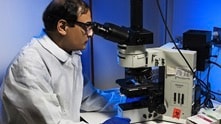Key points
- Balamuthia infections often are misdiagnosed as other illnesses.
- Tests are available to diagnose Balamuthia infections.
- CDC can help with testing for Balamuthia infections.

Testing and Diagnosing Balamuthia Infection
Clinicians
Balamuthia can cause a serious brain infection called granulomatous amebic encephalitis, or GAE. GAE can be confused with other neurologic diseases and conditions, even noninfectious ones like stroke.
GAE often is diagnosed only after someone dies. However, tests involving examining tissue samples or performing targeted testing from living patients are available.
Tests that can help confirm a diagnosis of GAE:
- Immunohistochemistry (IHC) and indirect immunofluorescence (IIF) staining use specific antibodies against Balamuthia to detect the ameba.
- A polymerase chain reaction (PCR) molecular assay can detect Balamuthia DNA in tissue.
CDC offers diagnostic assistance for Balamuthia to physicians and scientists through DPDx and the Free-living and Intestinal Amebas (FLIA) laboratory.
Morphology experts at DPDx can evaluate microscopic images, while the scientists at the FLIA laboratory provide diagnostic assistance using molecular and immunofluorescence assays.
